
 , 肖汉玉1,2, 袁瑞强3, 赵君1,2, 余小芳1,2
, 肖汉玉1,2, 袁瑞强3, 赵君1,2, 余小芳1,21. 江西师范大学鄱阳湖湿地与流域研究教育部重点实验室, 南昌 330022;
2. 江西师范大学地理与环境学院, 南昌 330022;
3. 山西大学环境与资源学院, 太原 030006
收稿日期: 2017-10-23; 修回日期: 2017-12-16; 录用日期: 2017-12-24
基金项目: 国家自然科学基金(No.41661017);江西省自然科学基金(No.20151BAB213035)
作者简介: 王鹏(1982—), 男, 副教授, 博士, 主要从事流域水环境和湖泊生态环境的研究.E-mail: wangpengjlu@jxnu.edu.cn
通讯作者(责任作者): 王鹏, E-mail:wangpengjlu@jxnu.edu.cn
摘要: 本次研究基于高通量测序技术分析了鄱阳湖入湖河口14处沉积物的真菌群落结构特征.测序得到的314条真菌OTU分属于9个门,25个纲,49个目,62个科,62个属和117个种.在OTU分类水平上,鄱阳湖主要支流入湖河口中除饶河、赣江南支和修水具有相近的真菌群落结构外,其它河口之间群落结构差异较大;真菌群落丰度、多样性与沉积物pH、有机碳、有机氮和C/N等环境因子没有显著相关性.在门分类水平上,丰度(序列数比例)最高的是子囊菌门(Ascomycota,49.4%),其次为壶菌门(Chytridiomycota,20.4%)和担子菌门(Basidiomycota,17.8%).与其它河口相比,赣江河口沉积物的水生环境真菌Chytridiomycota丰度显著较高,抚河河口沉积物的陆生环境真菌Basidiomycota丰度显著较高.有机碳是影响鄱阳湖入湖河口沉积物真菌群落门分类组成的主要环境因子,与Basidiomycota相对丰度正相关,与Chytridiomycota负相关,与Ascomycota相关性较弱.
关键词:鄱阳湖入湖河口沉积物高通量测序真菌群落环境因子
Fungal community in the estuarine sediment of Poyang Lake
WANG Peng1,2

 , XIAO Hanyu1,2, YUAN Ruiqiang3, ZHAO Jun1,2, YU Xiaofang1,2
, XIAO Hanyu1,2, YUAN Ruiqiang3, ZHAO Jun1,2, YU Xiaofang1,2 1. Key Laboratory of Poyang Lake Wetland and Watershed Research, Ministry of Education, Jiangxi Normal University, Nanchang 330022;
2. School of Geography and Environment, Jiangxi Normal University, Nanchang 330022;
3. School of Environment and Resource, Shanxi University, Taiyuan 030006
Received 23 October 2017; received in revised from 16 December 2017; accepted 24 December 2017
Supported by the National Natural Science Foundation of China (No. 41661017) and the Natural Science Foundation of Jiangxi Province (No.20151BAB213035)
Biography: WANG Peng(1982—), male, associate professor(Ph.D.)
*Corresponding author: WANG Peng, E-mail:wangpengjlu@jxnu.edu.cn
Abstract: In this study, high throughput sequencing was introduced to study the fungal community structure in 14 estuarine sediments of Poyang Lake. A total of 314 fungal OTUs were observed from sequencing, which were classified into 9 phyla, 25 classes, 49 orders, 62 families, 62 genera and 117 species. On the OTU level, similar fungal community structure was found among estuarine sediments of the Rao River, the southern branch of the Gan River and the Xiu River, while large differences existed between other estuarine sediments. The fungal richness and diversity were not significantly correlated with environmental factors, such as pH, organic carbon, organic nitrogen and C/N in estuarine sediments. On the phylum level, Ascomycota had the largest abundance of sequences (49.4%), followed by Chytridiomycota (20.4%) and Basidiomycota (17.8%). Compared with the fungal community structure in other estuarine sediments, the estuarine sediment in Gan River had significant higher abundance of Chytridiomycota, which originated from the aquatic environment; and the estuarine sediment in Fu River had significant higher abundance of Basidiomycota, which originated from the terrestrial environment. The organic carbon was the dominant environmental factor explaining the phylum community structure in the estuarine sediment of Poyang Lake, which was positively correlated with the relative abundance of Basidiomycota, negatively correlated with that of Chytridiomycota, and weakly correlated with that of Ascomycota.
Key words: Poyang Lakeestuarine sedimenthigh throughput sequencingfungal community structureenvironmental factors
1 引言(Introduction)微生物群落是水体沉积物中营养物质和能量循环转化的主要驱动者.真菌作为一种重要的微生物, 强大的胞外酶可以降解绝大部分有机质(Floudas et al., 2012);菌丝状形态使真菌能够深入营养物质, 在极端条件(如干旱、寒冷、强酸性)下仍能有效生长(Lee Taylor and Sinsabaugh, 2015).真菌的以上特性对水体沉积物中营养物质和能量循环转化起重要作用.但相对水生环境中细菌和古菌群落结构特征的众多研究(Lv et al., 2014; Ye et al., 2016; Zhang et al., 2015; 李靖宇等, 2015; 丁轶睿等, 2017; Hu et al., 2014), 水生环境中真菌群落的研究相对较少(B?rlocher and Boddy, 2016).
相对于传统的分离培养未能, 高通量测序技术能同时检测环境微生物中的优势物种、稀有物种及未知物种(刘驰等, 2015; Caporaso et al., 2011), 为真菌群落结构和影响因素的研究提供了技术支持.Panzer等(2015)总结了基于18S rRNA的环境真菌群落研究, 发现Ascomycota、Basidiomycota和Chytridiomycota是淡水真菌群落的主要组成.Wurzbacher等(2016)在研究德国Stechlin湖时发现, 沿湖岸至湖心有机质来源由陆生向水生转化, 沉积物真菌群落由Ascomycota为主向Chytridiomycota为主转化.但Liu等(2015)对松花江沉积物的研究发现地理位置(经度)对真菌群落的影响大于有机质等环境因子的影响;Li等(2016)对中国沿海潮间带沉积物的研究也得到类似结论.Wu等(2013)对中国20个地点沉积物的研究表明, 在大空间尺度(4000 km)上地理位置是影响真菌群落的主要因素, 在小空间尺度(<1000 km)上环境因子则是主要因素.
入湖河口是衔接河流与湖泊的过渡带, 是地表径流中污染物进入湖泊的缓冲区;营养物质的汇集和快速循环使入湖河口具有较高的生物生产力和生态多样性(Perissinotto et al., 2013).掌握入湖河口真菌群落结构及其影响因素, 有助于分析湖泊营养物质和有毒物质的来源和循环转化过程, 以及能量在食物链的传递过程(Wurzbacher et al., 2010).鄱阳湖是我国第一大淡水湖, 受赣江、抚河、饶河、信江和修水5条主要支流和长江水位影响, 湖泊水位季节性变化巨大, 形成了生态多样性丰富的淡水湿地系统(闵骞, 1995).受流域工农业发展影响, 近年来鄱阳湖外源性营养盐和重金属等污染物输入有增加的趋势(陈波等, 2016; 李艳红等, 2016; Yuan et al., 2011).部分****研究了鄱阳湖入湖河口沉积物的细菌群落结构及其与营养盐、重金属污染物的关系(江玉梅等, 2016; Sheng et al., 2016; Kou et al., 2016), 但真菌群落结构及其与环境因子的关系目前尚不清楚.本次研究基于高通量测序研究鄱阳湖入湖河口14处采样点沉积物的真菌群落结构特征.我们假设鄱阳湖入湖河口(小空间尺度)真菌群落主要受环境因子影响, 而不是地理位置;主要研究目的:①阐明鄱阳湖不同入湖河口沉积物真菌群落特征的差异;②探讨入湖河口沉积物真菌群落特征与环境因子的关系.
2 材料与方法(Materials and methods)2.1 样品采集与沉积物理化分析本次研究在鄱阳湖入湖河口设置14处采样点(图 1).分别位于修水河口(XS1)、赣江北支河口(GN2)、赣江北支和修水交汇处河口(GX3)、赣江北支、修水交汇后与鄱阳湖主航道交汇处(PY4)、赣江中支河口(GC5和GC6)、赣江南支河口(GS7)、信江河口(X8)、赣江南支、抚河和信汇交汇后河口(GFX9和GFX10)、抚河河口(F11和F12)、饶河河口(R13和R14).
图 1(Fig. 1)
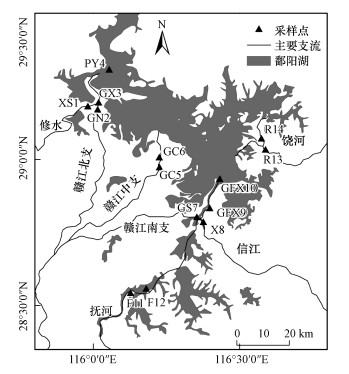 |
| 图 1 鄱阳湖入湖河口和采样点分布 Fig. 1Estuaries of Poyang Lake and the location of sampling sites |
采样在2016年12月枯水期进行, 在设计采样点及该点上、下游20 m处使用灭菌抓斗式底泥采样器采集0~10 cm表层底泥;每处采样点的3个重复底泥样品充分混合后装入灭菌自封袋, 冷藏带回实验室.用于高通量测序的沉积物样品在-80 ℃冰箱保存;用于理化分析的沉积物样品经真空冷冻干燥机(东京理化FDU-1200, 日本)去除水分、过1 mm筛后在-20 ℃冰箱保存.样品pH值加水后(1 : 2.5 (W/V))采用pH计测定, 有机碳(OC)和有机氮(ON)含量采用元素分析仪(Elementar, 德国)测定.
2.2 DNA提取与高通量测序采用FastDNATM Spin Kit for Soil(MPbio, 美国)提取样品基因组DNA, 采用1%琼脂糖凝胶电泳检测抽提的DNA.对18S rRNA基因进行PCR扩增, 引物序列为SSU0817F(5′-TTAGCATGGAATAATRR AATAGGA-3′)和1196R(5′-TCTGGACCTGGTGAG TTTCC-3′), 采用TransGen AP221-02(TransStart Fastpfu DNA Polymerase, 20 μL)反应体系.扩增条件为:95 ℃预变性3 min, 接着进行27个循环, 包括95 ℃变性30 s, 55 ℃退火30 s, 72 ℃延伸45 s;循环结束后72 ℃最终延伸5 min.每个样本3个重复, 将同一样本的PCR产物混合后用2%琼脂糖凝胶电泳检测, 利用AxyPrep DNA Gel Extraction Kit(Axygen Biosciences, 美国)进行纯化, Tris_HCl洗脱;2%琼脂糖电泳检测.参照电泳初步定量结果, 将PCR产物用QuantiFluorTM-ST蓝色荧光定量系统(Promega, 美国)进行检测定量.根据Illumina MiSeq平台(Illumina, 美国)标准操作规程将纯化后的扩增片段构建PE 2*250文库.测序在上海美吉生物医药科技有限公司的Illumina Miseq PE250平台进行.
2.3 数据统计处理用Usearch软件对Miseq测序数据进行质控过滤, 得到优化序列, 按照97%相似性将优化序列划分可操作分类单元(OTU, Operational Taxonomic Units), 采用RDP classifier贝叶斯算法对照Silva 128数据库以70%置信度对OTU代表序列进行物种分类.为避免各样品微生物量的差异, 按最小样本序列数进行样本序列抽平处理, 抽平后的数据用于后续统计分析.基于OTU计算覆盖度(Coverage)、Chao丰度指数和Shannon多样性指数.利用R语言Vegan软件包计算采样点真菌群落的Bray-Curtis距离矩阵, 基于Bray-Curtis距离做非度量多维尺度分析(NMDS)研究不同采样点真菌群落结构的差异性, 做冗余分析(RDA)研究环境因子对真菌群落的影响.采用单因素方差分析进行不同河口间沉积物环境因子、真菌群落丰度指数、多样性指数和真菌丰度差异的显著性检验(显著性水平p<0.05视为差异显著).统计分析中数据采用z-score方法标准化.
3 结果(Results)3.1 真菌群落结构14处沉积物高通量测序得到的真菌优化序列数为10721~33697;经抽平处理后, 以97%相似度划分共得到314条真菌OTU, 单个样品的OTU数量为62~194, 平均值为136(表 1).各样本文库的覆盖率(Coverage)范围均在99.7%以上, 说明沉积物中真菌基因序列检出概率很高, 能够代表群落的真实情况.Chao丰度指数和Shannon多样性指数的平均值分别为152和3.00.Chao指数最大值出现在修水(XS1), Shannon指数最大值出现在赣江南支(GS7);Chao指数和Shannon指数最小值都出现在鄱阳湖主航道下游(PY4).14处采样点沉积物的Chao指数和Shannon没有显著相关性(r=0.36, p=0.204).
表 1(Table 1)
| 表 1 鄱阳湖入湖河口沉积物真菌群落高通量测序数据、多样性指数和环境因子 Table 1 High throughput sequencing data, diversity indices of fungal community and environmental factors in the estuarine sediment of Poyang Lake | |||||||||||||||||||||||||||||||||||||||||||||||||||||||||||||||||||||||||||||||||||||||||||||||||||||||||||||||||||||||||||||||||||||||||||||||||||||||||
表 1 鄱阳湖入湖河口沉积物真菌群落高通量测序数据、多样性指数和环境因子 Table 1 High throughput sequencing data, diversity indices of fungal community and environmental factors in the estuarine sediment of Poyang Lake
| |||||||||||||||||||||||||||||||||||||||||||||||||||||||||||||||||||||||||||||||||||||||||||||||||||||||||||||||||||||||||||||||||||||||||||||||||||||||||
OTU分类水平的NMDS分析(图 2)表明饶河(R13和R14)、赣江南支(GS7)、修水(XS1)以及修水和赣江北支汇合后(GX3)的河口沉积物真菌群落结构相近, Chao丰度指数显著高于其它采样点(p=0.003).抚河、信江和赣江南支汇合后的GFX9采样点真菌群落结构与抚河相近, GFX10采样点真菌群落结构与赣江南支相近.信江(X8)、赣江北支(GN2)和鄱阳湖主航道(PY4)真菌群落结构与其它河口差异较大;抚河(F11、F12和GFX9)真菌群落结构与其它河口差异也较大;以上两组河口具有显著较低的Shannon多样性指数(p=0.03);赣江中支(GC5和GC6)真菌群落结构与其它河口差异较大.以上分析表明, 鄱阳湖主要支流入湖河口中, 除饶河、赣江南支和修水具有相近的真菌群落结构外, 其它河口差异较大.
图 2(Fig. 2)
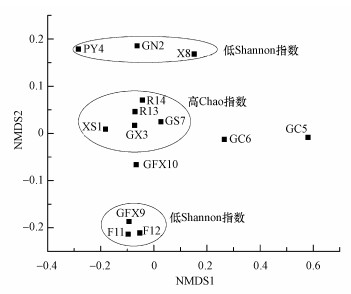 |
| 图 2 鄱阳湖入湖河口沉积物真菌群落在OTU水平的非度量多维尺度分析图(NMDS) Fig. 2Nonmetric Multidimensional Scaling (NMDS) plots on OTU level for the fungal community in estuarine sediment of Poyang Lake |
3.2 真菌群落物种分类高通量测序得到的314条OTU分属于9个门、25个纲、49个目、62个科和62个属和117个种.在分类学数据库分类谱系的中间等级、没有科学名称的真菌物种, 以norank作为标记;在分类学数据库分类谱系中无法找到的序列以unclassified标记.将以上两类真菌视为未分类真菌, 则314条OTU(相应序列数)在门、纲、目、科和属分类水平上分别有29.0%(9.8%)、73.6%(39.7%)、80.6%(60.3%)、93.6%(87.1%)和94.6%(96.0%)属于未分类真菌.
在门水平分类上(图 3), 鄱阳湖河口沉积物中真菌相对丰度(序列数比例)最高的是子囊菌门(Ascomycota, 49.4%), 其次为壶菌门(Chytridiomycota, 20.4%)和担子菌门(Basidiomycota, 17.8%).另外有1种未分类真菌(unclassified_Fungi)丰度达到6.9%, 其余门分类真菌丰度小于3%.14处河口采样点沉积物中, 赣江南支、中支和北支(包括与修水汇合后的GX3)的Chytridiomycota平均丰度(38.1%)显著高于其它河口(10.7%)(p=0.005);抚河(包括与信汇、赣江南支汇合后的GFX9和GFX10)的Basidiomycota平均丰度(41.1%)显著高于其它河口(8.5%)(p<0.001).
图 3(Fig. 3)
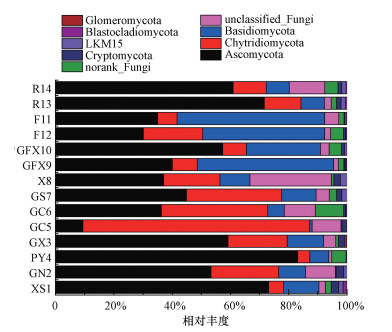 |
| 图 3 鄱阳湖入湖河口沉积物真菌门分类丰度 Fig. 3Relative abundances of fungal phyla in the estuarine sediment of Poyang Lake |
真菌群落进化树图(图 4)表明Ascomycota中丰度较高的为亲缘关系接近的座囊菌纲(Dothideomycetes, 19.0%)、粪壳菌纲(Sordariomycetes, 12.2%)和散囊菌纲(Eurotiomycetes, 10.1%);Chytridiomycota只含有一种未确定名称的纲分类真菌(norank_Chytridiomycota), 与其它所有真菌群落的亲缘关系都较远;Basidiomycota以伞菌纲(Agaricomycetes, 15.2%)为主.在检测出的所有25种纲分类真菌中, Ascomycota和Basidiomycota各占了9种, 是真菌多样性的主要构成.
图 4(Fig. 4)
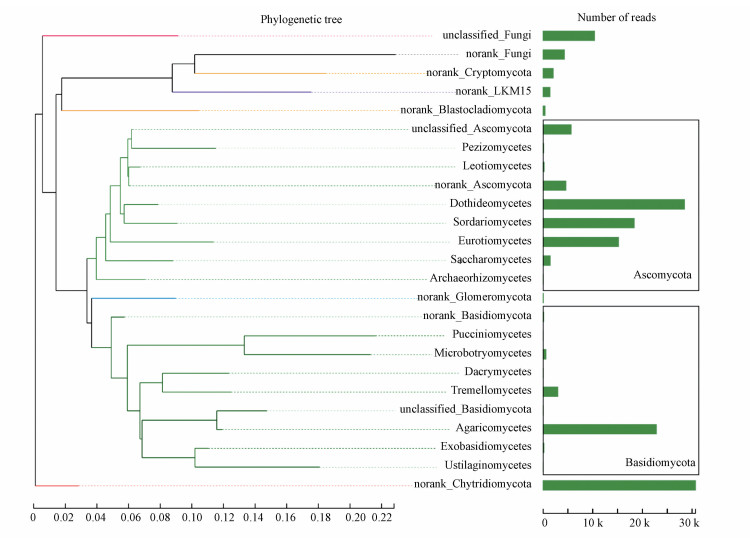 |
| 图 4 鄱阳湖入河湖口沉积物纲分类水平真菌群落进化树图 Fig. 4Phylogenetic tree on class level for fungal community in estuarine sediment of Poyang Lake |
3.3 环境因子与真菌群落研究区沉积物的pH值范围为5.56~7.37, OC含量为0.02%~1.35%, ON含量为0.01%~0.19%, C/N为2.00%~8.75%(表 1).赣江南支、中支和北支(包括与修水汇合后的GX3)沉积物的OC、ON、C/N显著低于其它河口;抚河(包括与信汇、赣江南支汇合后的GFX9和GFX10)沉积物的OC、ON、C/N显著高于其它河口;研究区沉积物的pH、OC、ON、C/N与Chao丰度指数或Shannon多样性指数之间均没有显著相关性.
图 5为环境因子对主要门分类真菌群落(平均丰度大于1%)的冗余分析结果, 第一主轴解释了门分类群落74.6%的方差变化, 第一主轴和第二主轴一共解释了95.6%.其中OC对门分类群落影响的显著性最高(p=0.030);ON和C/N对门分类群落的影响与OC类似, 但ON和C/N的影响不显著(p值分别为0.206和0.636);pH的影响也不显著(p=0.976).所以OC是影响鄱阳湖入湖河口沉积物真菌群落组成的主要环境因子.OC含量与Ascomycota相关性较弱, 与Chytridiomycota呈负相关关系, 与Basidiomycota呈正相关关系.
图 5(Fig. 5)
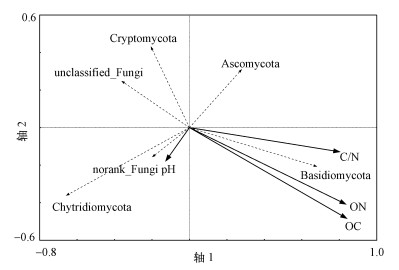 |
| 图 5 真菌门分类群落与环境因子的冗余分析 Fig. 5Redundancy analysis of fungal phyla and environmental parameters |
4 讨论(Discussion)本次研究对鄱阳湖入湖河口沉积物18S rRNA高通量测序得到的真菌序列数和OTU在门分类水平上分别有9.8%和29.0%属于未分类真菌;测序序列在目及其以下分类水平超过60%属于未分类真菌, OTU在纲及其以下分类水平超过70%属于未分类真菌;以上说明在鄱阳湖入湖河口沉积物中存在大量未知真菌物种.Zhang等(2015)对中国北方3座水库沉积物的高通量测序发现超过65%的真菌序列在门分类水平上属于未分类真菌, 但Yu等(2017)在小清河至莱州湾沉积物的高通量测序则只有3.2%的真菌序列在门水平上无法分类.与陆生真菌相比, 水生真菌的研究相对较少(B?rlocher and Boddy, 2016);在目前被发现的大约100000种真菌中, 只有3000种来自水生环境(Tsui et al., 2016).大量未知真菌的存在给研究鄱阳湖河口真菌群落的生态功能带来困难;随着高通量测序技术在真菌群落的应用和水生环境真菌生态功能的研究深入, 迫切需要加强真菌生命树的系统发育分析.
本次研究发现鄱阳湖入湖河口沉积物真菌丰度最高的是Ascomycota(49.4%), 其次为Chytridiomycota (20.4%)和Basidiomycota(17.8%).国内外针对水体沉积物真菌研究得到的优势菌群主要是Ascomycota和Basidiomycota, 或Chytridiomycota(表 2).Panzer等(2015)统计了公共数据库中的真菌18S rRNA基因序列, 发现Chytridiomycota是第三大真菌分类, 但在淡水水体中是第一大真菌分类.B?rlocher和Boddy (2016)总结了不同环境下的真菌研究结果, 发现水生真菌中以Ascomycota和Chytridiomycota为主, 陆生真菌以Ascomycota和Basidiomycota为主.Chytridiomycota主要以死亡的水生植物或水环境中的其他碎屑物质为食, 释放的游动孢子又被浮游动物捕食, 在水域食物网中起重要作用(Kagami et al., 2014).本次研究中赣江河口沉积物中Chytridiomycota丰度显著高于其它河口, 可能是由于赣江河流最长, 流量最大, 与其它河流相比具有更明显的水生环境.Basidiomycota是陆生环境真菌群落的主要组成(Buee et al., 2009), 本次研究中Basidiomycota以Agaricales和Thelephorales主, 两者都是典型的外生根菌(Khomich et al., 2017);抚河河口具有显著较高的Basidiomycota丰度可能是受到抚河下游平原灌区外源性输入的影响, 抚河河口沉积物中相对较高的碳氮含量也证实了较多的外源性有机质输入.
表 2(Table 2)
| 表 2 水体沉积物真菌群落及影响因子研究结果 Table 2 Fungal communities and the influencing factors in studies of water sediment | ||||||||||||||||||||||||||||||||||||||||||||||||
表 2 水体沉积物真菌群落及影响因子研究结果 Table 2 Fungal communities and the influencing factors in studies of water sediment
| ||||||||||||||||||||||||||||||||||||||||||||||||
本次研究中鄱阳湖主要支流入湖河口沉积物真菌群落丰度、多样性与环境因子没有显著相关性.与细菌相比, 真菌的胞外酶和菌丝结构能够更有效的吸收营养物质(Lee Taylor and Sinsabaugh, 2015), 从而减少了对环境因子的依赖.除热泉(刘开辉等, 2017)和人工污染溪流(Volant et al., 2016)等特殊环境外, 多数研究也没有发现沉积物理化参数对真菌群落有显著影响(表 2).本次研究中尽管真菌群落丰度和多样性受沉积物理化参数影响不显著, 但在门分类水平上, 沉积物有机碳是影响鄱阳湖入湖河口沉积物真菌群落组成的主要环境因子(图 5), 其中Basidiomycota与有机碳正相关, Chytridiomycota与有机碳负相关, Ascomycota与有机碳相关性较弱.Basidiomycota是陆生真菌, 水体沉积物中Basidiomycota丰度与外源性有机质输入密切相关(B?rlocher and Boddy, 2016), 从而与有机碳呈明显正相关关系.Chytridiomycota主要以水生植物残体为食(Kagami et al., 2014), 而河流沉积物有机质含量主要来自陆地的外源性输入, 从而使鄱阳湖河口沉积物Chytridiomycota相对丰度与有机碳含量呈负相关关系.Ascomycota是本次研究中真菌群落中的最大门类, 主要由Dothideomycetes, Sordariomycetes和Eurotiomycetes构成, 这3种真菌分布广泛, 存在于所有生境类型中(Panzer et al., 2015);丰度最高的Dothideomycetes具有多样的生态功能和环境适应性(Ohm et al., 2012).Ascomycota较强的环境适应性使其与沉积物有机碳的相关性很弱.
5 结论(Conclusions)1) 鄱阳湖入湖河口沉积物中存在大量未知真菌物种.高通量测序得到的真菌序列数和OTU在门分类水平上分别有9.8%和29.0%属于未分类真菌;测序序列在目及其以下分类水平超过60%属于未分类真菌, OTU在纲及其以下分类水平超过70%属于未分类真菌.大量未知真菌物种的存在给深入研究鄱阳湖河口真菌群落的生态功能带来困难.
2) 鄱阳湖入湖河口沉积物真菌丰度最高的是Ascomycota(49.4%), 其次为Chytridiomycota(20.4%)和Basidiomycota(17.8%).赣江河口沉积物的水生环境真菌Chytridiomycota丰度显著高于其它河口, 抚河河口沉积物的陆生环境真菌Basidiomycota丰度显著高于其它河口.
3) 鄱阳湖入湖河口沉积物真菌群落丰度、多样性与环境因子没有显著相关性, 表明真菌具有较强的环境适应性.在门分类水平上, 由于不同真菌利用有机质的来源和种类差异, 有机碳成为影响鄱阳湖入湖河口沉积物真菌群落组成的主要环境因子.
参考文献
| B?rlocher F, Boddy L. 2016. Aquatic fungal ecology-How does it differ from terrestrial?[J]. Fungal Ecology, 19: 5–13.DOI:10.1016/j.funeco.2015.09.001 |
| Buee M, Reich M, Murat C, et al. 2009. 454 Pyrosequencing analyses of forest soils reveal an unexpectedly high fungal diversity[J]. New Phytologist, 184(2): 449–456.DOI:10.1111/j.1469-8137.2009.03003.x |
| Caporaso J G, Lauber C L, Walters W A, et al. 2011. Global patterns of 16S rRNA diversity at a depth of millions of sequences per sample[J]. Proceedings of the National Academy of Sciences of the United States of America, 108(Supplement 1): 4516–4522. |
| 陈波, 王鹏, 张华. 2016. 鄱阳湖水体氮磷污染研究进展[J]. 江西师范大学学报(自然科学版), 2016, 40(4): 437–441. |
| 丁轶睿, 李定龙, 张毅敏, 等. 2017. 滆湖底泥细菌群落结构及多样性[J]. 环境科学学报, 2017, 37(5): 1649–1656. |
| Floudas D, Binder M, Riley R, et al. 2012. The Paleozoic origin of enzymatic lignin decomposition reconstructed from 31 fungal genomes[J]. Science, 336(6089): 1715–1719.DOI:10.1126/science.1221748 |
| 郭庆兰, 刘开辉, 丁小维, 等. 2014. 内蒙古鄂尔多斯一古盐湖真菌多样性及其功能酶的初步筛选[J]. 微生物学通报, 2014, 41(8): 1547–1555. |
| Hu A, Yang X, Chen N, et al. 2014. Response of bacterial communities to environmental changes in a mesoscale subtropical watershed, Southeast China[J]. Science of The Total Environment, 472: 746–756.DOI:10.1016/j.scitotenv.2013.11.097 |
| 江玉梅, 张晨, 黄小兰, 等. 2016. 重金属污染对鄱阳湖底泥微生物群落结构的影响[J]. 中国环境科学, 2016, 36(11): 3475–3486.DOI:10.3969/j.issn.1000-6923.2016.11.034 |
| Kagami M, Miki T, Takimoto G. 2014. Mycoloop:chytrids in aquatic food webs[J]. Frontiers in Microbiology, 5: 166. |
| Khomich M, Davey M L, Kauserud H, et al. 2017. Fungal communities in Scandinavian lakes along a longitudinal gradient[J]. Fungal Ecology, 27(A): 36–46. |
| Kohout P, Sykorova Z, Ctvrtlikova M, et al. 2012. Surprising spectra of root-associated fungi in submerged aquatic plants[J]. FEMS Microbiology Ecology, 80(1): 216–235.DOI:10.1111/j.1574-6941.2011.01291.x |
| Kou W, Zhang J, Lu X, et al. 2016. Identification of bacterial communities in sediments of Poyang Lake, the largest freshwater lake in China[J]. SpringerPlus, 5(1): 401.DOI:10.1186/s40064-016-2026-7 |
| Lee Taylor D, Sinsabaugh R L. 2015. The soil fungi: occurrence, phylogeny, and ecology//Paul E A. Soil Microbiology, Ecology and Biochemistry (Fourth Edition)[M]. Boston: Academic Press. 77-109 |
| 李靖宇, 杜瑞芳, 赵吉. 2015. 乌梁素海富营养化湖泊湖滨湿地过渡带细菌群落结构的高通量分析[J]. 微生物学报, 2015, 55(5): 598–606. |
| Li W, Wang M, Bian X, et al. 2016. A high-level fungal diversity in the intertidal sediment of Chinese seas presents the spatial variation of community composition[J]. Frontiers in Microbiology, 7: 2098. |
| 李艳红, 葛刚, 胡春华, 等. 2016. 基于聚类分析和因子分析的鄱阳湖流域水质时空变化特征及污染源分析[J]. 南昌大学学报(理科版), 2016, 40(4): 360–365. |
| 刘驰, 李家宝, 芮俊鹏, 等. 2015. 16S rRNA基因在微生物生态学中的应用[J]. 生态学报, 2015, 35(9): 2769–2788. |
| Liu J, Wang J, Gao G, et al. 2015. Distribution and diversity of fungi in freshwater sediments on a river catchment scale[J]. Frontiers in Microbiology, 6: 329. |
| 刘开辉, 丁小维, 张波, 等. 2017. 高通量测序分析云南腾冲热海热泉真菌多样性[J]. 微生物学报, 2017, 57(9): 1314–1322. |
| Lv X, Yu J, Fu Y, et al. 2014. A meta-analysis of the bacterial and archaeal diversity observed in wetland soils[J]. The Scientific World Journal, 2014: 437684. |
| 闵骞. 1995. 鄱阳湖水位变化规律的研究[J]. 湖泊科学, 1995, 7(3): 281–288.DOI:10.18307/1995.0312 |
| Ohm R A, Feau N, Henrissat B, et al. 2012. Diverse lifestyles and strategies of plant pathogenesis encoded in the genomes of eighteen dothideomycetes fungi[J]. PLoS Pathogens, 8: e100303712. |
| Panzer K, Yilmaz P, Wei? M, et al. 2015. Identification of habitat-specific biomes of aquatic fungal communities using a comprehensive nearly full-length18S rRNA dataset enriched with contextual data[J]. PLoS ONE, 10(7): e134377. |
| Perissinotto R, Stretch D D, Taylor R H. 2013. Ecology and Conservation of Estuarine Ecosystems:Lake St Lucia as a Global Model[M]. Cambridge: Cambridge University Press: 381–396. |
| Richards T A, Leonard G, Mahe F, et al. 2015. Molecular diversity and distribution of marine fungi across 130 European environmental samples[J]. Proceedings of the Royal Society B-Biological Sciences, 282(1819): 20152243.DOI:10.1098/rspb.2015.2243 |
| Sheng P, Yu Y, Zhang G, et al. 2016. Bacterial diversity and distribution in seven different estuarine sediments of Poyang Lake, China[J]. Environmental Earth Sciences, 75(6): 479.DOI:10.1007/s12665-016-5346-6 |
| Tsui C K M, Baschien C, Goh T. 2016. Biology and Ecology of Freshwater Fungi//Li D. Biology of Microfungi[M]. Cham: Springer International Publishing. 285-313 |
| Tsuji M, Fujiu S, Xiao N, et al. 2013. Cold adaptation of fungi obtained from soil and lake sediment in the Skarvsnes ice-free area, Antarctica[J]. FEMS Microbiology Letters, 346(2): 121–130.DOI:10.1111/fml.2013.346.issue-2 |
| Volant A, Héry M, Desoeuvre A, et al. 2016. Spatial distribution of eukaryotic communities using high-throughput sequencing along a pollution gradient in the arsenic-rich creek sediments of Carnoulès mine, France[J]. Microbial Ecology, 72(3): 608–620.DOI:10.1007/s00248-016-0826-5 |
| Wu B, Tian J, Bai C, et al. 2013. The biogeography of fungal communities in wetland sediments along the Changjiang River and other sites in China[J]. The ISME Journal, 7(7): 1299–1309.DOI:10.1038/ismej.2013.29 |
| Wurzbacher C, B?rlocher F, Grossart H P. 2010. Fungi in lake ecosystems[J]. Aquatic Microbial Ecology, 59: 125–149.DOI:10.3354/ame01385 |
| Wurzbacher C, Warthmann N, Bourne E, et al. 2016. High habitat-specificity in fungal communities in oligo-mesotrophic, temperate Lake Stechlin (North-East Germany)[J]. MycoKeys, 16: 17–44.DOI:10.3897/mycokeys.16.9646 |
| 宣淮翔, 安树青, 孙庆业, 等. 2011. 太湖不同湖区水生真菌多样性[J]. 湖泊科学, 2011, 23(3): 469–478. |
| Ye F, Wu S, Jiang Y, et al. 2016. Shifts of archaeal community structure in soil along an elevation gradient in a reservoir water level fluctuation zone[J]. Journal of Soils and Sediments, 16(12): 2728–2739.DOI:10.1007/s11368-016-1485-3 |
| Yu S, Pang Y, Wang Y, et al. 2017. Spatial variation of microbial communities in sediments along the environmental gradients from Xiaoqing River to Laizhou Bay[J]. Marine Pollution Bulletin, 120: 90–98.DOI:10.1016/j.marpolbul.2017.04.059 |
| Yuan G, Liu C, Chen L, et al. 2011. Inputting history of heavy metals into the inland lake recorded in sediment profiles:Poyang Lake in China[J]. Journal of Hazardous Materials, 185(1): 336–345.DOI:10.1016/j.jhazmat.2010.09.039 |
| Zhang H, Huang T, Chen S. 2015. Ignored sediment fungal populations in water supply reservoirs are revealed by quantitative PCR and 454 pyrosequencing[J]. BMC Microbiology, 15: 44.DOI:10.1186/s12866-015-0379-7 |
| Zhang J, Yang Y, Zhao L, et al. 2015. Distribution of sediment bacterial and archaeal communities in plateau freshwater lakes[J]. Applied Microbiology and Biotechnology, 99(7): 3291–3302.DOI:10.1007/s00253-014-6262-x |
